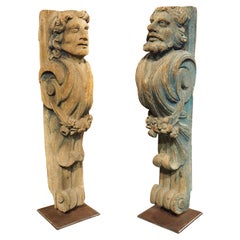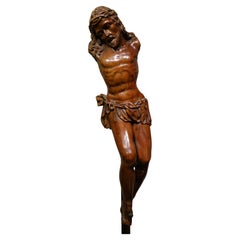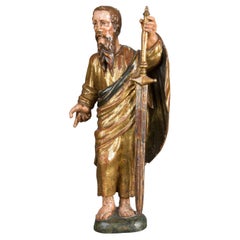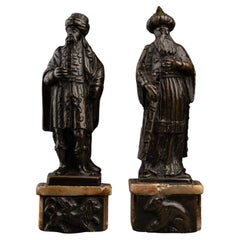Renaissance Decorative Objects
Spanning an era of cultural rebirth in Europe that harkened back to antiquity, the Renaissance was a time of change in design. From the late 1400s to the early 1600s, Rome, Venice and Florence emerged as artistic centers through the expansion of global trade and a humanist belief in the arts being central to society. Antique Renaissance furniture was ornately carved from sturdy woods like walnut, its details standing out against the tapestries and stained glass adorning the walls.
Renaissance chests, which were frequently commissioned for marriages, were often decorated with gilding or painted elements. Those that were known as cassoni were crafted in shapes based on classical sarcophagi. As opposed to the medieval era, when furniture was pared down to the necessities, a wide range of Renaissance chairs, tables and cabinets were created for the home, and the designs regularly referenced ancient Rome.
Large torchères of the Renaissance era that were used as floor lamps were inspired by classical candelabras, while marble surfaces evoked frescoes. The inlaid boxes being imported from the Middle East informed the intarsia technique, which involved varying hues of wood in mosaic-like patterns, such as those by architect Giuliano da Maiano in the Florence Cathedral.
Tapestry-woven cushion covers accented the variety of Renaissance seating — from conversation to study chairs — while bookcases for secular use reflected the migration of culture and knowledge from the church into the home. The aesthetics of the Italian Renaissance later spread to France through the publishing of work by renowned designers, including Hugues Sambin and Jacques Androuet du Cerceau. Centuries later, the 19th-century Renaissance Revival would see a return to this influential style.
Find a collection of antique Renaissance case pieces, decorative objects and other furniture on 1stDibs.
16th Century German Antique Renaissance Decorative Objects
Bronze
16th Century European Antique Renaissance Decorative Objects
Metal, Iron
Early 17th Century French Antique Renaissance Decorative Objects
Boxwood
16th Century Spanish Antique Renaissance Decorative Objects
Other
17th Century Italian Antique Renaissance Decorative Objects
Alabaster, Bronze
15th Century and Earlier Italian Antique Renaissance Decorative Objects
Marble
16th Century Spanish Antique Renaissance Decorative Objects
Wood
16th Century Belgian Antique Renaissance Decorative Objects
Bronze
16th Century Belgian Antique Renaissance Decorative Objects
Wood
18th Century Portuguese Antique Renaissance Decorative Objects
Wood
15th Century and Earlier Italian Antique Renaissance Decorative Objects
Terracotta
16th Century Italian Antique Renaissance Decorative Objects
Giltwood
Late 17th Century Portuguese Antique Renaissance Decorative Objects
Wood
16th Century Italian Antique Renaissance Decorative Objects
Bronze
16th Century German Antique Renaissance Decorative Objects
Wood, Pine
16th Century Dutch Antique Renaissance Decorative Objects
Oak
15th Century and Earlier Italian Antique Renaissance Decorative Objects
Gold Leaf
17th Century Italian Antique Renaissance Decorative Objects
Stone
17th Century Spanish Antique Renaissance Decorative Objects
Wood
16th Century European Antique Renaissance Decorative Objects
Bronze
Mid-18th Century French Antique Renaissance Decorative Objects
Bronze
17th Century German Antique Renaissance Decorative Objects
Silver
16th Century Italian Antique Renaissance Decorative Objects
Gold Leaf
17th Century Spanish Antique Renaissance Decorative Objects
Boxwood
16th Century European Antique Renaissance Decorative Objects
Wood
15th Century and Earlier French Antique Renaissance Decorative Objects
Limestone
16th Century Italian Antique Renaissance Decorative Objects
Stucco, Wood, Paper
16th Century Belgian Antique Renaissance Decorative Objects
Bronze
16th Century French Antique Renaissance Decorative Objects
Oak
18th Century Portuguese Antique Renaissance Decorative Objects
Wood
17th Century Spanish Antique Renaissance Decorative Objects
Brass
15th Century and Earlier Italian Antique Renaissance Decorative Objects
Marble
16th Century European Antique Renaissance Decorative Objects
Bronze, Wrought Iron
16th Century Spanish Antique Renaissance Decorative Objects
Bone, Walnut
16th Century Spanish Antique Renaissance Decorative Objects
Gold Leaf
17th Century Belgian Antique Renaissance Decorative Objects
Marble, Belgian Black Marble
16th Century Czech Antique Renaissance Decorative Objects
Bronze
18th Century Italian Antique Renaissance Decorative Objects
Marble
Early 17th Century Italian Antique Renaissance Decorative Objects
Wood, Walnut
16th Century Italian Antique Renaissance Decorative Objects
Terracotta
16th Century Italian Antique Renaissance Decorative Objects
Marble
17th Century Italian Antique Renaissance Decorative Objects
Stone, Bronze
16th Century German Antique Renaissance Decorative Objects
Gesso, Wood
Early 17th Century Italian Antique Renaissance Decorative Objects
Giltwood
17th Century German Antique Renaissance Decorative Objects
Stoneware
18th Century Italian Antique Renaissance Decorative Objects
Giltwood
15th Century and Earlier Italian Antique Renaissance Decorative Objects
Gesso, Wood
18th Century Italian Antique Renaissance Decorative Objects
Wood
18th Century Italian Antique Renaissance Decorative Objects
Wood, Fruitwood
16th Century German Antique Renaissance Decorative Objects
Wood
16th Century Italian Antique Renaissance Decorative Objects
Carrara Marble, Iron, Gold Leaf
17th Century French Antique Renaissance Decorative Objects
Bronze
16th Century Italian Antique Renaissance Decorative Objects
Giltwood
16th Century Italian Antique Renaissance Decorative Objects
Paper
Early 17th Century Italian Antique Renaissance Decorative Objects
Bronze
Early 17th Century Italian Antique Renaissance Decorative Objects
Marble, Bronze
15th Century and Earlier Italian Antique Renaissance Decorative Objects
Iron
17th Century Moroccan Antique Renaissance Decorative Objects
Copper, Tin
15th Century and Earlier German Antique Renaissance Decorative Objects
Wood
Late 17th Century Belgian Antique Renaissance Decorative Objects
Wood, Chestnut





